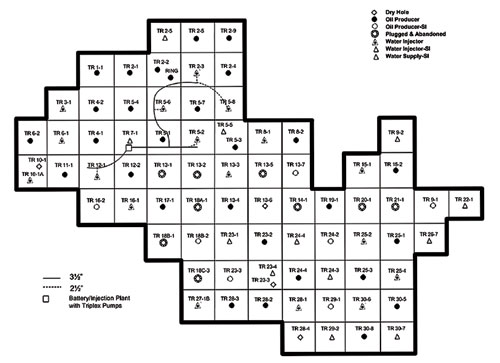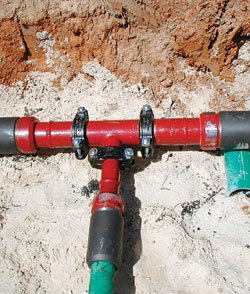|
|
|

By Petroleum Technology Transfer Council |
Coiled composite line pipe: An attractive injection system replacement
By 2003, repeated failures with injection lines in the mature field initiated an analysis to find the best solution if the waterflood project were to continue.
Ken Oglesby, Oak Resources, Inc., Tulsa, Oklahoma; James Williams, Phoenix PetroCorp Inc., Dallas, Texas; and Rufus Mullins, Fiberspar Corp., Houston, Texas
Looking at the attractive remaining reserves and property life, operator Oak Resources, Inc. (Unit now operated by Phoenix PetroCorp Inc.) elected to replace the injection lines and continue the waterflood using coiled, continuous, composite pipe instead of carbon steel pipe (internal and external coated) or jointed fiberglass pipe. While the overall installed cost would have been about the same for the different systems evaluated, the deciding factors were the ease of installation, the short downtime of wells and roads, and the projected long-term reliability. After trenching, it took only 1-1/2 days in April 2003 to install about one mile of mixed 3-1/2- and 2-1/2-in. OD lines, including pressure testing. The total installed cost was less than $8 per foot. Only two failures (within 14 days and 10 ft of each other) were experienced within one year of installation, and both were attributed to localized damage during installation. Otherwise the system has performed very well, as expected.
BACKGROUND
The West Brock Penn Unit is a waterflood production unit in Carter County, south central Oklahoma. Originally drilled in the 1940s, the Unit was formed on October 1, 1972, and water injection commenced in mid-1973. Not surprisingly, production is very mature with about 65 bopd being produced from 15 active producers. Water cut is very high, about 98%, with over 3,700 bpd of water. All produced water is reinjected using Triplex pumps at an injection system pressure of about 1,100 psi. Despite the waterflood's maturity, the unit is profitable under normal operating conditions. Oak operated the unit from 1987 until late 2003, when the property was sold to Phoenix PetroCorp Inc.
In 2000, low oil prices and repeated failures in the injection line system caused the waterflood to be severely restricted. At that time, Oak looked at three options: 1) abandoning the unit's waterflood operation; 2) converting to a low-pressure water-disposal operation into the Arbuckle formation; or 3) replacing the injection system and continue waterflooding. The high remaining reserves and long property life dictated continuing the waterflood operation.
Oak considered several factors when looking at the options for replacing the injection system. One was cost, including installation and maintenance over the life of the system. Another was ease of installation – which affects downtime and cost. The last considerations centered around reliability, which could be affected by the number of connections, corrosion resistance (total dissolved solids were about 159,000 mg/l with a pH of 6.5), and long-term material durability/ stability.
Oak considered conventional carbon steel pipe (coated internally and externally), jointed high-pressure fiberglass, and coiled composite line pipe. Composite pipe consists of an inner thermoplastic pressure barrier that is reinforced by high-strength glass fibers embedded in an epoxy matrix. Standard high-density polyethylene is used for temperatures up to 140°F, while cross-linked polyethylene is rated to 180°F. FiberSpar's 1,500-psi rated, LinePipe-branded product was selected based on rated performance data and the product's installation history.
The overall installed costs for the different material systems were in the same range, so ease and timing of installation, and projected long-term reliability were the deciding factors. Jointed fiberglass and coiled composite pipe both offer excellent corrosion resistance and have a decided advantage over carbon steel pipe, even if it is coated. Installed properly and operated within appropriate conditions, both fiberglass and composite pipe possess long-term material stability. However, in Oak's experience, jointed-pipe systems provide numerous potential leak points during both installation and in long-term operation. Flow resistance (friction) of internally-coated steel, fiberglass and composite materials are all much lower than for bare steel, but not significantly different between themselves.
FIELD INSTALLATION
Fig. 1 shows the Unit boundary and illustrates where the new injection lines were installed. Oak chose to discontinue waterflooding/ injection in the southeastern portion of the Unit because of poorer reservoir quality and an active creek crossing that would make the installation much more difficult and costly. However, the option to replace injection lines in this area is still open. Thus, only injection lines in the prime northern and western areas were replaced.
 |
Fig. 1. Unit map with replacement injection lines noted.
|
|
In preparing for installation, Oak used a backhoe to dig a 24-in.-wide, 3-ft-deep trench. Trenchers could have been used, but with numerous lines that crossed existing flowlines, electrical lines and pipelines, the backhoe operation was considered more practical. The backhoe also allowed a wider trench cut (not required by the manufacturer) than possible with available trenchers, which Oak thought would provide more protection. Also not required by the manufacturer, Oak chose to bed the trench with sand to minimize pipe contact with rocks. Tracer lines and tape were also laid alongside and above the composite pipe to make finding the pipe easier should repairs or other nearby digging ever be needed in the future.
In April 2003, Fiberspar and Oak field crews installed and pressure tested 5,425 ft of combined 3-1/2- and 2-1/2-in. line pipe within a day and a half (see Fig. 2). Most of the installation time dealt with installing connections and not line laying. The pipe was pressure tested to 2,300 psi, or about 150% of its 1,500 psi rated capacity. Normally this type of pipe is covered before pressure testing, since there are no connectors to leak. But since it was Oak's first installation of this type of system, the pressure test was performed with the pipe uncovered. Without any overburden to hold the pipe in place, the overall length shrank (as diameter expanded) during pressure testing. Line length was not recovered when depressurized. This shrinkage is not a problem if planned or if the lines are mostly covered during testing.
 |
Fig. 2. Composite fiber tee connection.
|
|
FIELD PERFORMANCE
Installation went faster than planned, taking much less installation time than jointed fiberglass or steel systems would have taken. As previously noted, only two failures (within 10 ft and 14 days of each other) were experienced about one year after installation near the west end of the injection distribution system. Analysis of the failures by the manufacturer identified the likely cause as being localized damage during initial installation. Since the pressure test was performed before the back filling operation, there is a high likelihood that the damage occurred during back filling. The manufacturer has since revised installation procedures to make testing after back filling a standard procedure. Despite the leaks, Oak and Phoenix are satisfied with the installation. Phoenix will continue to monitor performance and, in future installations, closely follow installation recommendations.
OVERALL PRODUCT EXPERIENCE
Fiberspar has installed over 3 million ft of pipe in North America over the past four years, with outstanding performance. Many major operators are now converting to this technology and seeing the benefits of fast, safe installation. Problems are rare and usually attributed to early handling or installation problems, as contractors and users gain experience with this new technology. In Alberta, Canada, over 40 samples of this pipe were recovered and extensively tested after 2 to 3 years of widely varied service, in conjunction with the regulatory authority in Alberta, the AUEB. In every case, the pipe was in virtually “as new” condition. This compared to conventional steel pipe that would have severely degraded from corrosion in most of these cases over the same time period. 
THE AUTHORS
|
 |
Ken Oglesby, president of Oak Resources, Inc., has a BS in petroleum engineering and an MS in engineering from the University of Tulsa. Oak focuses on new technology to improve productivity and lower costs for oil and gas production and drilling operations. He may be reached via email at oakk@aol.com.
|
 |
James Williams, vice president of engineering for Phoenix PetroCorp, has 20 years of industry experience focused in secondary and enhanced oil recovery projects. He has a BS degree in mechanical engineering from Oklahoma State University. He may be reached via email at jwpetro@comcast.net.
|
 |
Rufus Mullins has 35 years of oil and gas industry experience in various international and domestic locations. With Fiberspar, he is responsible for marketing and customer service to domestic clients. He may be reached via email at rmullins@fiberspar.com.
|
|







